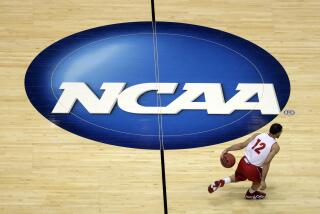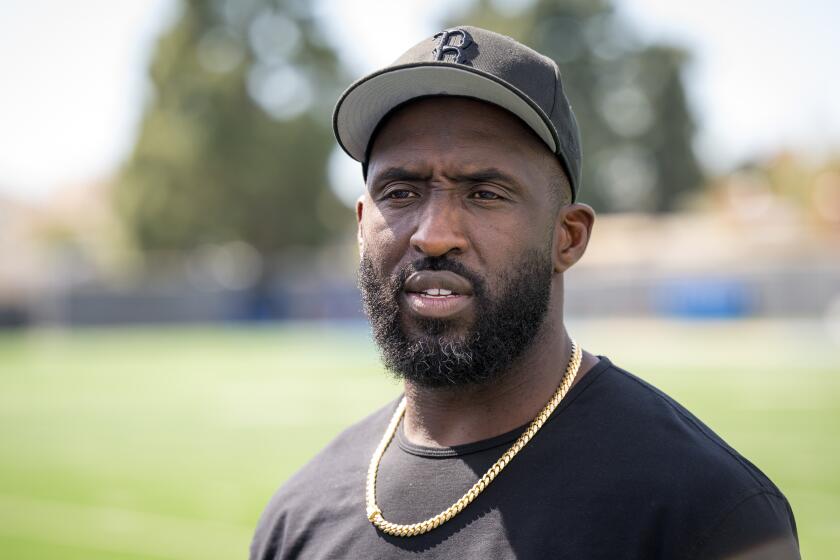Players left out of the Mad money
- Share via
UCLA on top of the world one minute, then down in the dumps and sent packing the next. USC proving the Pac-10 tournament wasn’t a fluke. The Cowboys of Oklahoma State and the Volunteers of Tennessee trading last-minute haymakers like Ali against Frazier, their final round, their final fight.
This is a beautiful time of year. Sit back, breathe in March Madness, enjoy.
Just don’t get bamboozled, for there is more to this heart-thumping event -- America’s two-week Spring Hoops Fling -- than what shows. My advice: Love every minute of the slick production, the colors, the gloss. But don’t forget, you’re watching a charade.
The NCAA trumps itself up as guardian of the lofty ideal of amateurism. How sweet.
“But this is only amateur for the college athlete, and for some of them, amateurism is a stretch,” said Randy Grant, who recently co-authored “The Economics of Intercollegiate Sports” and is an economics professor at Oregon’s Linfield College.
“It’s certainly not amateur for the schools or coaches,” he said. “No, this is big, big business.”
The NCAA will end up reeling in $6 billion from CBS for the current TV deal, which ends in 2013. A $6-billion treasure trove, and that’s to say nothing of the myriad corporate sponsorships. Not bad for an entity protected by non-profit, tax-exempt status because of its “educational mission.”
Yet there are some schools in the tournament that seem to understand what education means. Based on the most recent NCAA graduation success-rate survey, which followed freshmen who entered school no later than 2001, seven tournament teams graduated their players at a 100% clip. Kudos to Utah State, Western Kentucky, Robert Morris, Marquette, Binghamton, Wake Forest and Florida State.
“That’s real progress,” said Richard Lapchick, director of University of Central Florida’s Institute for Diversity and Ethics in Sport, when we spoke by phone Friday. “You have a coach like Leonard Hamilton at Florida State, and he’s making a commitment to his players that is paying off. . . . But we still have a ways to go.”
He means that there still are too many teams, like Cal State Northridge and USC, in jeopardy of losing scholarships because the latest NCAA progress reports have them on pace to graduate less than 60% of their players. Not a good sign, particularly seen from a longer view. That NCAA graduation success survey showed only 37% of USC basketball players earned degrees. At Northridge, it was 8%.
Yeah, I know, you’re feeling queasy. Me too. Want to feel better? Then love the furious passion of a Blake Griffin, the jump-out-of-the-gym Oklahoma forward, plowing toward another heavy dunk.
But don’t forget that Griffin, like every single player in the tournament, is a pawn.
Sure, many of these basketball studs get full-ride scholarships. But when you compare the price of a scholarship -- often a $20,000-to-$30,000 benefit -- to the hundreds of millions made from their sweat, where’s the fairness? There is none.
It hardly ends there. Players (who might better be termed laborers, given the boatloads of cash they produce for their schools) can lose their scholarships at the end of any year for any reason, even a whim. It’s the coach’s call.
Moreover, NCAA transfer rules often strip players of the freedom to move around that other students enjoy because if you switch schools at the wrong time, you have to sit out for a year. And when these players need advice on the future, they’re stuck on an island, alone. Even those on a surefire path to the NBA can’t hire an agent without losing their eligibility.
If the players are pawns, the coaches, like most of the suits in this often-smarmy athletic cartel, are kings. They work backed by contracts cast in stone. Nothing will be taken from them on a whim.
Money is still a dream away for the honest student-athletes, who often find themselves leaning on their families.
“A lot of those families, they’re so broke they can’t even afford a ticket to these NCAA games,” reminded Harry Edwards, sociology professor emeritus at California, when we spoke this week.
While some players can’t afford to go to the student union and buy an NCAA-approved replica jersey with their own number on it, coaches make out better and better every year. Florida’s Billy Donovan makes $3.5 million. His team didn’t make the tournament. Ohio State did. Their coach makes $2.5 million. UCLA, we know, made the dance. Ben Howland brings in roughly $2 million yearly.
And yet any of these coaches could quit their gigs in June, get hired by a rival school in July, have a fat deal worked out by their agent, and suffer nothing in the way of an NCAA penalty. It pays to be a king.
All of this points to a different kind of madness -- one steeped in double-talk about amateurism and academics.
Not that you shouldn’t enjoy the rest of the tournament. Love it, in fact, for every ounce of its pageantry and passion. Just don’t forget it’s also a charade.
And not just in March.
--
More to Read
Go beyond the scoreboard
Get the latest on L.A.'s teams in the daily Sports Report newsletter.
You may occasionally receive promotional content from the Los Angeles Times.







